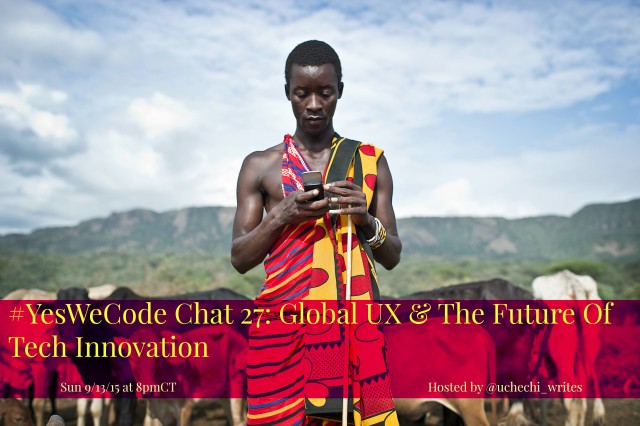
by Uchechi | Sep 12, 2015 | Blog
This week, Apple announced the new iPhone release for later this month. Around the world, customers will line up in Mexico City, Lagos, Lisbon and Manila to purchase Apples latest artistic release.In a world that has more mobile phones than toilets, it’s clear that global ad diverse customers make our products more profitable and valuable.
Isn’t it time we represent our world not just as consumers, but also as creators?
As tech innovators, how do we create user experiences that factor in the needs, desires and worldviews of global population?
Do we have a responsibility to innovate with a focus on global user experiences?
I think we do! As a UX Designer, I’m always thinking about how my Nigerian, American, Swedish, Mexican and Jewish family engages with the products I create.
How do I factor them into my design process?
The conversation about diversity in technology often centers around bringing diverse ideas to the table for the sake of inclusion, but the need for inclusion goes beyond fairness and equality. It also allows for better user experience, better design and more innovative products.
Stepping outside our comfort zone is not only necessary for self growth, it’s also good (no great) for business. The future of technology will focus on creating products for the more than 7 billion people in the world (4.5 billion have mobile technology) who look like less like the 19 year old white male Stanford grad and more like a kaleidoscope of ethnicities, languages and cultural contexts.
We are the answer to the question, “who will be best positioned to come up with products and services that will win in the global market.”
I think it’s time we make sure global centered UX is at the core of our tech diversity conversations and design innovation.
Questions to think about:
- What does global UX mean to you?
- Do you practice it?
- How has it impacted your design experience and perspective?
- As consumers, how would global centered design impact your user experience of a product?
- As creators, do we have a responsibility to “think globally?”
- As outsiders, do people of color have an advantage in the global market of tech products?
- If so how can we promote that?

by Uchechi | Jun 14, 2015 | Blog, creativity
I didn’t major in CS
I didn’t go to UX design school. I don’t think it even existed when I graduated from college in 2001. While I didn’t know anything about user experience design, I did know that I was interested in human behavior and interactions. User Experience Designers come from all different majors and backgrounds.I thought I’d major in Environmental Science. I loved learning how things worked, especially in the environment.During the spring of my freshman year, I took a poetry class that would eventually lead me to a career in technology.
Poetry Taught Me To Love Creativity and Language
I know this doesn’t sound like a predictable path, but it came out of going for something that ignited my curiosity, and led me to a career I didn’t even know I’d want to pursue.I was lucky to be mentored by the late poet June Jordan. She was one of the most published black writers in US history and I found a resonance in our stories. She encouraged me to express myself, to take risks, to get on stage even when my nerves were fried and my poems were drenched in my own fear. She made it valuable to take risks for something important, which was finding and owning my voice.
It was UX love at first wireframe
Years later, I found myself with a career as a professional poet, teacher and online copywriter. I’d spend weekends performing at conferences, jails, schools and more. What I loved most about this work was that it made me engage with my audience in a way that brought us all closer together. I’d write a range of content and was always aware of the language I used and the emotions conveyed based on the words I chose.I loved how language had an impact and could affect how we felt about anything. I learned to be intentional with my language and to use it wisely to convey exactly what I wanted to say.
User Experience Design Was Similar to Poetry
Online copywriting led me to discover UX, and it was love at first wireframe. Something about User Experience felt familiar.
- I got to have a voice and to use it.
- I could create something that allowed me to engage with my audience of users.
- It allowed me to be intentional about language and to not waste words.
- I had to think about who my audience was, and create experiences they could connect to.
- My platform was no longer a stage, but was now online. The world could connect. The world became my users.
- I could still be very creative and use writing as a tool.
- UX was also all about great copy, and I loved writing great copy to create great experiences. I was in tech heaven.
Want to know how to get into a tech career?
Start with finding your voice
If you’re headed to college, everyone will want to give you advice about what you should major in. You don’t know me and you might not want my advice, so I’ll tell you what I believe instead. I believe true creativity is rooted in any discipline that allows you to find a voice and to believe that your voice matters. Once you find that, you can express it in several ways (poetry, fine art, technology), but you have to trust that your perspective has value.
Suggested Classes To Take (You can do these now, even if you’re not in college anymore):
- Take classes that help you find your voice. Theater and creative writing classes are great for this.
- Take classes that reinforce the idea that mistakes are okay, and sometimes your best way of learning. Art classes are great for this.
- Take classes that encourage you to get up and share your perspective. Often in UX, you end up working in teams and need to be able to explain your ideas to others. Public speaking classes are great for this.
- Do something that allows you to take risks. Reading a poem during open mic night at your local bar is a great way to do this.
- Take classes in Architecture, which allows you to understand structural planning, which will help you in User Experience Design.[“Tweet “Creativity is rooted in the belief that you have a voice and that your voice matters enough to share it with the world.”]
Conclusion:
As a tech entrepreneur, I often get asked how I found this career path. My first response is usually something like this: “No, I didn’t major in CS, but I did study creative writing and education.” I was obsessed with language, perspectives and what it meant to have a voice and to trust that voice. It was trusting that voice that led me to love language enough to pursue a writing career, which led to online copywriting and then to UX. The skills I learned as a poet have also applied to my UX career. If you want to know how to get into tech, my advice is to find your creativity by finding your voice.How did you get into tech? How did you find your way to teI’d love to know your story. Hit me up in the comments!

